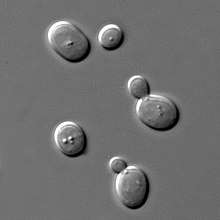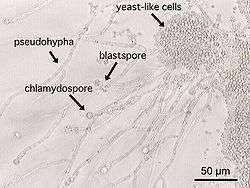Anti–Saccharomyces cerevisiae antibody
Anti-Saccharomyces cerevisiae antibodies (ASCAs) are antibodies against antigens presented by the cell wall of the yeast Saccharomyces cerevisiae. ASCAs and perinuclear antineutrophil cytoplasmic antibodies (pANCAs) are the two most useful and often discriminating biomarkers for colitis.[1] ASCA tends to recognize Crohn's disease more frequently, whereas pANCA tend to recognize ulcerative colitis.[2]
| Antibody(s) | |
|---|---|
| Anti-saccharomyces cerevisiae | |
| Antigen Isoform | Mannans |
| Antigen Source | Saccharomyces cerevisiae |
| Antigen gene | pro |
| Affected organ(s) | Large Intestine |
| Affected tissue(s) | Epithelium |
| Associated Disease(s) | Colitis |
ASCA antibodies react to a yeast protein with mannans,[3] a 200-kDa glycoprotein.[4] Diseases in which ASCA are found include the following:
- Behçet's disease[5] - The association with ASCA is not generally strong, but increased in patients with gastrointestinal symptoms.[6]
- Celiac disease[7][8]
- Colitis[7]
- Ulcerative colitis-familial.[9]
- Microscopic colitis
- Collagenous colitis[10]
- Crohn's disease[11][12]

Intestinal yeast and ASCA+. Intestinal yeast infections are seen in malabsorptive diseases like coeliac disease. In Crohn's disease and ulcerative colitis the presence of intestinal S. cerevisiae is rare, but the association with irritiable bowel in coeliac disease remains unstudied.[13]
Anti-mannans

Mannan (oligomannan) is a component of the yeast cell wall. Antibodies to yeast mannans are found at increased frequency in Crohn's disease and ASCA+ Crohn's tend to have lower low levels of mannan-binding lectin.[14] Experimentally, antibodies to mannans from yeast can also crossreact to mannans of other types of yeast.[15] Study of the sugars indicated that a mannotetraose (4-mer) was responsible for highest response. [16] Studies of the 200 kDa glycoprotein antibodies found them commonly in healthy people, suggesting that the disease associated antibodies are to their carbohydrate moieties.[17] Mannans from other yeast, for example candida albicans, have found to cross react with ASCA which suggests that other yeast may induce ASCA associated diseases.
Mannan-binding lectin (MBL) is a lectin produced by humans. In ASCA+ Crohn's disease the serum level of this protein is lower. Cellular response to mannan in ASCA+ peripheral blood lymphocytes could be inhibited by adding MBL, however, a high frequency of mutations in the MBL gene was found in ASCA+ patients.[18] Besides, MBL serum levels were inversely correlated with ASCA levels in Crohn’s disease patients with severe clinical phenotypes.[19]
Crohn's disease
ASCA are consistently higher in frequency in Crohn's disease. Yeast cause a three-fold increase in lymphocyte proliferation relative to normal controls.[20] The ASCA antibodies are also more frequently found in familial Crohn's disease.[9] An altered humoral and cellular response to mannan is observed and may be due to a loss of yeast tolerance.[21] This alteration is marked by increased activation markers, CD25/CD69, upon proliferative stimulation of T-helper lymphocytes. ASCA+ is a predictor for Crohn's disease with high specificity and positive predictive value (87% and 78% respectively).[22] ASCA are associated with proximal (gastroduodenal and small bowel involvement) rather than purely colonic disease (P < 0.001) and with a more severe disease phenotype and requirement for surgery over a median follow-up time of 9 years (P < 0.0001). There is no association between genetic markers for Crohn's disease and NOD2/CARD15 or MP (IgA or IgG) indicating heterogeneous causes for Crohn's disease.[23] Experimental studies show that chemically-induced colitis promotes opportunistic human fungal pathogen Candida albicans colonization. In turn, Candida albicans colonization generates ASCA.[24]
References
- Desplat-Jégo S, Johanet C, Escande A, et al. (2007). "Update on Anti-Saccharomyces cerevisiae antibodies, anti-nuclear associated anti-neutrophil antibodies and antibodies to exocrine pancreas detected by indirect immunofluorescence as biomarkers in chronic inflammatory bowel diseases: results of a multicenter study". World J. Gastroenterol. 13 (16): 2312–8. doi:10.3748/wjg.v13.i16.2312. PMC 4147139. PMID 17511029.
- Joossens S, Reinisch W, Vermeire S, et al. (2002). "The value of serologic markers in indeterminate colitis: a prospective follow-up study". Gastroenterology. 122 (5): 1242–1247. doi:10.1053/gast.2002.32980. PMID 11984510.
- Lindberg E, Magnusson KE, Tysk C, Järnerot G (1992). "Antibody (IgG, IgA, and IgM) to baker's yeast (Saccharomyces cerevisiae), yeast mannan, gliadin, ovalbumin and betalactoglobulin in monozygotic twins with inflammatory bowel disease". Gut. 33 (7): 909–913. doi:10.1136/gut.33.7.909. PMC 1379403. PMID 1644330.
- Heelan BT, Allan S, Barnes RM (1991). "Identification of a 200-kDa glycoprotein antigen of Saccharomyces cerevisiae". Immunol. Lett. 28 (3): 181–185. doi:10.1016/0165-2478(91)90001-Q. PMID 1885214.
- Monselise A, Weinberger A, Monselise Y, Fraser A, Sulkes J, Krause I (2006). "Anti-Saccharomyces cerevisiae antibodies in Behçet's disease--a familial study". Clin. Exp. Rheumatol. 24 (5 Suppl 42): S87–90. PMID 17067434.
- Fresko I, Ugurlu S, Ozbakir F, et al. (2005). "Anti-Saccharomyces cerevisiae antibodies (ASCA) in Behçet's syndrome". Clin. Exp. Rheumatol. 23 (4 Suppl 38): S67–70. PMID 16273768.
- Giaffer MH, Clark A, Holdsworth CD (1992). "Antibodies to Saccharomyces cerevisiae in patients with Crohn's disease and their possible pathogenic importance". Gut. 33 (8): 1071–1075. doi:10.1136/gut.33.8.1071. PMC 1379444. PMID 1398231.
- Toumi D, Mankaï A, Belhadj R, Ghedira-Besbes L, Jeddi M, Ghedira I (2007). "Anti-Saccharomyces cerevisiae antibodies in coeliac disease". Scand. J. Gastroenterol. 42 (7): 821–826. doi:10.1080/00365520601154996. PMID 17558905.
- Annese V, Andreoli A, Andriulli A, et al. (2001). "Familial expression of anti-Saccharomyces cerevisiae Mannan antibodies in Crohn's disease and ulcerative colitis: a GISC study". Am. J. Gastroenterol. 96 (8): 2407–2412. doi:10.1111/j.1572-0241.2001.04043.x. PMID 11513182.
- Holstein A, Burmeister J, Plaschke A, Rosemeier D, Widjaja A, Egberts EH (2006). "Autoantibody profiles in microscopic colitis". J. Gastroenterol. Hepatol. 21 (6): 1016–1020. doi:10.1111/j.1440-1746.2005.04027.x. PMID 16724988.
- Main J, McKenzie H, Yeaman GR, et al. (1988). "Antibody to Saccharomyces cerevisiae (bakers' yeast) in Crohn's disease". BMJ. 297 (6656): 1105–1106. doi:10.1136/bmj.297.6656.1105. PMC 1834894. PMID 3143445.
- Barnes RM, Allan S, Taylor-Robinson CH, Finn R, Johnson PM (1990). "Serum antibodies reactive with Saccharomyces cerevisiae in inflammatory bowel disease: is IgA antibody a marker for Crohn's disease?". Int. Arch. Allergy Appl. Immunol. 92 (1): 9–15. doi:10.1159/000235217. PMID 2246081.
- Mallant-Hent RC, Mooij M, von Blomberg BM, Linskens RK, van Bodegraven AA, Savelkoul PH (2006). "Correlation between Saccharomyces cerevisiae DNA in intestinal mucosal samples and anti-Saccharomyces cerevisiae antibodies in serum of patients with IBD". World J. Gastroenterol. 12 (2): 292–7. doi:10.3748/wjg.v12.i2.292. PMC 4066041. PMID 16482632.
- Seibold F, Boldt AB, Seibold-Schmid B, et al. (2007). "Association of deficiency for mannan-binding lectin with anti-mannan antibodies in Crohn's disease: A family study". Inflamm. Bowel Dis. 13 (9): 1077–1082. doi:10.1002/ibd.20156. PMID 17480019.
- Schaffer T, Müller S, Flogerzi B, Seibold-Schmid B, Schoepfer AM, Seibold F (2007). "Anti-Saccharomyces cerevisiae mannan antibodies (ASCA) of Crohn's patients crossreact with mannan from other yeast strains, and murine ASCA IgM can be experimentally induced with Candida albicans". Inflammatory Bowel Diseases. 13 (11): 1339–1346. doi:10.1002/ibd.20228. PMID 17636567.
- Sendid B, Colombel JF, Jacquinot PM, et al. (1996). "Specific antibody response to oligomannosidic epitopes in Crohn's disease". Clin. Diagn. Lab. Immunol. 3 (2): 219–26. PMC 170283. PMID 8991640.
- Sander U, Kunze I, Bröker M, Kunze G (1998). "Humoral immune response to a 200-kDa glycoprotein antigen of Saccharomyces cerevisiae is common in man". Immunol. Lett. 61 (2–3): 113–117. doi:10.1016/S0165-2478(98)00003-0. PMID 9657263.
- Seibold F, Konrad A, Flogerzi B, et al. (2004). "Genetic variants of the mannan-binding lectin are associated with immune reactivity to mannans in Crohn's disease". Gastroenterology. 127 (4): 1076–1084. doi:10.1053/j.gastro.2004.07.056. PMID 15480986.
- Choteau Laura; Vasseur Francis; Lepretre Frederic; Figeac Martin; Gower-Rousseau Corine; Dubuquoy Laurent; Poulain Daniel; Colombel Jean-Frederic; Sendid Boualem; Jawhara Samir (2016). "Polymorphisms in the Mannose-Binding Lectin Gene are Associated with Defective Mannose-Binding Lectin Functional Activity in Crohn's Disease Patients". Scientific Reports. 6 (1): 29636. doi:10.1038/srep29636. ISSN 2045-2322. PMC 4940739. PMID 27404661.
- Young CA, Sonnenberg A, Burns EA (1994). "Lymphocyte proliferation response to baker's yeast in Crohn's disease". Digestion. 55 (1): 40–43. doi:10.1159/000201121. PMID 8112496.
- Konrad A, Rütten C, Flogerzi B, Styner M, Göke B, Seibold F (2004). "Immune sensitization to yeast antigens in ASCA-positive patients with Crohn's disease". Inflamm. Bowel Dis. 10 (2): 97–105. doi:10.1097/00054725-200403000-00006. PMID 15168808.
- [citation needed]
- Walker LJ, Aldhous MC, Drummond HE, et al. (2004). "Anti-Saccharomyces cerevisiae antibodies (ASCA) in Crohn's disease are associated with disease severity but not NOD2/CARD15 mutations". Clin. Exp. Immunol. 135 (3): 490–496. doi:10.1111/j.1365-2249.2003.02392.x. PMC 1808965. PMID 15008984.
- Jawhara Samir; Thuru Xavier; Standaert‐Vitse Annie; Jouault Thierry; Mordon Serge; Sendid Boualem; Desreumaux Pierre; Poulain Daniel (April 2008). "Colonization of Mice byCandida albicansIs Promoted by Chemically Induced Colitis and Augments Inflammatory Responses through Galectin‐3". The Journal of Infectious Diseases. 197 (7): 972–980. doi:10.1086/528990. ISSN 0022-1899. PMID 18419533.